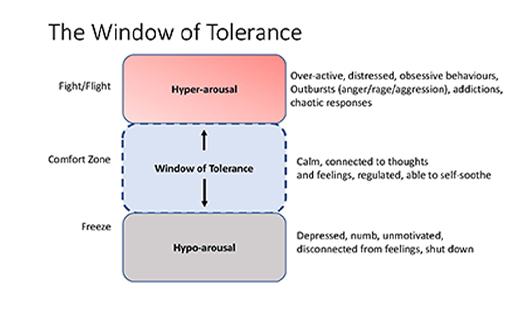1 Emotional engagement
As you learned in Week 2 there are a variety of emotional responses to the climate and ecological crisis. You may experience anxiety, depression, anger, guilt or a numbing of emotional response. Part of living with the crisis will involve acknowledging and engaging with these emotions and processing them in such a way that they are not overwhelming but, at the same time, enable you to act in ways which are part of mitigating the crisis.
One useful concept that helps us to manage potentially overwhelming emotions is to think about our individual window of tolerance (Siegel, 1999).
The idea is that we each have a window of tolerance when it comes to distress. This is the amount of stress that we can tolerate and still stay present and connected to our thoughts and feelings. We all have a threshold. When we experience more stress than we can tolerate, we go to the edges of our window. On the one hand, this can mean we become hyper-aroused, commonly known as the fight/flight response. This can present as anxiety or anger, we can become impulsive or drawn into obsessive, even addictive behaviours like drinking too much alcohol, compulsive shopping or over-working.
On the other hand, we may become hypo-aroused with the so-called freeze response. We can feel numb, disconnected, depressed and flat.
Each time we are exposed to new reports or documentaries about the climate crisis, when we think about the impact of what is happening, we can feel shock. As the reality dawns on us, it can push us out of our window of tolerance. We may lose the ability to stay present and resilient and engaged with the situation.
In order to stay within our window of tolerance we need to notice what’s happening within ourselves. Are we feeling anxious or irritable? Or are we feeling flat or even numb? We can then do things which are calming and soothing to bring us back within our window of tolerance.
Activity 1 Soothing and calming
Make a list of the kinds of things that you find soothing and calming when you are distressed (hyper-aroused). What activities help to enliven you if you feel flat or disconnected (hypo-aroused)? What support do you need?
Another model which can be helpful comes from grief theory. Worden (2015) suggests that processing grief associated with loss involves working through psychological ‘tasks’ which we can either face into or avoid. These tasks are:
- Accepting the loss
- Working through the painful emotions
- Adjusting to the new reality
- Reinvesting emotional energy
These tasks are not linear or ever really completed. They are always there and we find ourselves returning to them repeatedly.
Activity 2 Tasks of grief
Watch the video of psychotherapist Rosemary Randall discussing Worden’s grief model in relation to the climate and ecological crisis.

Transcript
- Do you recognise these tasks in your own attempts at thinking realistically about the crisis?
- Which tasks have you found most difficult?
- What would you find helpful when approaching these tasks?
Discussion
One of the things that Rosemary stresses is the importance of getting support from others. It is important to have people to talk to who take those concerns seriously and make you feel it is OK to talk about it. It is not helpful, for instance, to try to argue with someone who is strongly defended and perhaps in a state of denial. If that someone happens to be a family member or friend it can be particularly difficult and it may be preferable to avoid the subject rather than try to convince them of the reality of the climate crisis. The other person may cling to their view even more strongly to avoid the shame and embarrassment of being wrong.
Although Worden’s tasks-based model focuses on grief, it is important to acknowledge, talk about, and understand whatever emotions may be present. Being open about them means you will be better able to work through them.
Finding groups in your own community is especially valuable, because practical local solutions can arise that help with feelings of powerlessness and hopelessness. For example, working on improving green spaces together, or campaigning for bike lanes to reduce the number of cars being driven. Being part of a group can help to reduce distress. It gives a sense of togetherness and belonging and creates social bonds which help us to feel supported as we manage our feelings.

